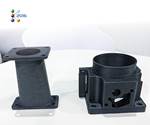SPE's Polyolefins Highlights: Materials & Additives
New semi-crystalline SEBS, additives for improved discoloration resistance, plant-based antioxidants, online compounding of TPO blends and more discussed in Houston.
SPE Polyolefins 2017 did not disappoint on its second full day (first day highlights here). For one thing, there was an early but super nice St. Patrick’s Day celebration during one of breaks on, replete with a terrific sounding pipe band and green layer cake too!
Beyond the surprise entertainment/cake, the materials and additives technologies discussed were also a treat. Whether unveiling a new product or applying existing products in intriguing and novel ways to boost performance of polyolefins, there were plenty of highlights:
• Kraton unveiled a new semi-crystalline SEBS that shows excellent compatibility with PE for making elastic films and compounds as well as fibers. MB1653 SEBS, now made in pilot plant quantities, is said to be one of, if not the most, high flow product of its kind.
• BASF presented the latest work by its plastic additives business aimed at optimizing stabilization systems for improved discoloration resistance in critical polyolefin applications including cast and blown PE films and injection molded PP.
One key takeaway: remove traditional long-term thermally stable antioxidant in applications where the product is not intended for long-term or multiple uses.
• Chitec Technology launched a novel plant-based dialkyl hydroxylamine antioxidant (DAHA). While DAHA AOs have a negative impact on long-term stabilization, this palm-based DAHA AO combined with a HALS stabilizer outperforms a traditional phenolic AO.
• Dow Chemical discussed online compounding of TPO blends for large part thermoforming and the development of an HMS-TPO for this purpose.
• Total Cray Valley discussed its newly launched Dymalink 9200 zinc diacrylate salt (also offered as 9201 masterbatch) for making compounded HMS-PP.
• Baerlocher gave a presentation on its new Baeropol RST...previously reported in PT's Feb. 2017 issue...K 2016 Materials and Additives. It’s claim to fame is that it can reduce use of phosphite AOs in polyolefins and can also be used to assist in switching away from TNPP.
• Dow presented the latest on its Innate precision packaging resins launched in 2015. Made with a novel non-metallocene catalyst and a new process, these resins can be made with various copolymers. Innate ST50 (0.85 MI, 0.918 density) 1-mil film exhibits comparable if not better puncture resistance and better optics vs. a competitive mLLDPE.
In heavy-duty sacks, Innate shows outstanding toughness performance. In bag-in-box liquid packaging, Innate resins show excellent stiffness/toughness balance vs. mLLDPE. Down gauging with Innate shows a significant reduction in flex cracking.
Overall, these resins boast film toughness without compromising stiffness or other properties.

Related Content
-
Solve Four Common Problems in PET Stretch-Blow Molding
Here’s a quick guide to fixing four nettlesome problems in processing PET bottles.
-
Foam-Core Multilayer Blow Molding: How It’s Done
Learn here how to take advantage of new lightweighting and recycle utilization opportunities in consumer packaging, thanks to a collaboration of leaders in microcellular foaming and multilayer head design.
-
Best Methods of Molding Undercuts
Producing plastics parts with undercuts presents distinct challenges for molders.
















